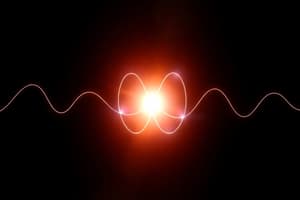Podcast
Questions and Answers
Which type of spectrum consists of distinct lines?
Which type of spectrum consists of distinct lines?
- Absorption spectrum
- Line spectrum (correct)
- Emission spectrum
- Continuous spectrum
What happens to the electron in an atom when it emits light of specific wavelengths?
What happens to the electron in an atom when it emits light of specific wavelengths?
- The electron jumps from lower energy level to higher energy level
- The electron remains in the same energy level
- The electron jumps from higher energy level to lower energy level (correct)
- The electron disappears
How can line spectrum be produced?
How can line spectrum be produced?
- By passing a gas through electric discharge tube at high pressure
- By cooling gaseous or solid atoms
- By heating gaseous or solid atoms
- By passing a gas through electric discharge tube at low pressure (correct)
What does the line spectrum serve as for identification of elements?
What does the line spectrum serve as for identification of elements?
What does the line spectrum of sodium look like?
What does the line spectrum of sodium look like?
Which type of spectrum consists of distinct lines separated by dark spaces?
Which type of spectrum consists of distinct lines separated by dark spaces?
Which of the following represents the energy difference between the excited and ground state of an atom?
Which of the following represents the energy difference between the excited and ground state of an atom?
What happens to the electrons in an atom when it emits light of specific wavelengths?
What happens to the electrons in an atom when it emits light of specific wavelengths?
How can line spectrum be produced?
How can line spectrum be produced?
What does the line spectrum of an element serve as?
What does the line spectrum of an element serve as?
Flashcards
Line Spectrum
Line Spectrum
A spectrum consisting of separate, distinct lines.
Electron Transition in Emission
Electron Transition in Emission
When an electron in an atom emits light of specific wavelengths, it transitions from a higher energy level to a lower energy level.
Producing a Line Spectrum
Producing a Line Spectrum
Passing a gas through an electric discharge tube at low pressure creates a line spectrum.
Line Spectrum as Fingerprint
Line Spectrum as Fingerprint
Signup and view all the flashcards
Sodium Line Spectrum
Sodium Line Spectrum
Signup and view all the flashcards
Wavelengths and Energy Difference
Wavelengths and Energy Difference
Signup and view all the flashcards
Electron Transition in Absorption
Electron Transition in Absorption
Signup and view all the flashcards
Line Spectrum Production
Line Spectrum Production
Signup and view all the flashcards
Line Spectrum as Element Fingerprint
Line Spectrum as Element Fingerprint
Signup and view all the flashcards
Applications of Line Spectra
Applications of Line Spectra
Signup and view all the flashcards
Study Notes
Line Spectrum
- A line spectrum consists of distinct lines, produced when electrons in an atom transition from a higher energy level to a lower energy level, emitting light of specific wavelengths.
Electron Energy Transitions
- When an electron in an atom emits light of specific wavelengths, it transitions from a higher energy level to a lower energy level, releasing energy in the form of photons.
Producing Line Spectra
- Line spectra can be produced by heating an element, causing the electrons to transition from a higher energy level to a lower energy level, emitting light of specific wavelengths.
Identification of Elements
- The line spectrum of an element serves as a unique identifier, allowing for the identification of elements based on their distinct line spectra.
Sodium's Line Spectrum
- The line spectrum of sodium appears as a yellow doublet, characteristic of sodium.
Discrete Spectrum
- A discrete spectrum consists of distinct lines separated by dark spaces.
Energy Difference
- The energy difference between the excited and ground state of an atom represents the energy emitted or absorbed during an electron transition.
Electron Transitions
- When electrons in an atom emit light of specific wavelengths, they transition from a higher energy level to a lower energy level, releasing energy in the form of photons.
Line Spectrum Significance
- The line spectrum of an element serves as a unique fingerprint, allowing for the identification of elements based on their distinct line spectra.
Studying That Suits You
Use AI to generate personalized quizzes and flashcards to suit your learning preferences.




